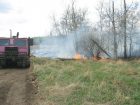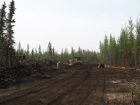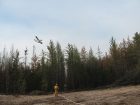
Features
Training
Wildfire Week
Dozer Boss: How firefighters are using bulldozers to combat wildfires
Increasingly, municipal firefighters are being called to fight wildland fires and fires in the wildland urban interface. Departments should cultivate a good understanding of wildland fire behaviour, suppression techniques, and above all, safety. One less familiar tactic municipal firefighters sometimes face is the use of bulldozers (dozers) in fireline construction. This article will provide an overview of why and how dozers are used to control wildfires.
March 2, 2018
By David Moseley
 When it’s safe to be on the line Bulldozers may not fit on the truck as part of a firefighter’s regular toolkit
When it’s safe to be on the line Bulldozers may not fit on the truck as part of a firefighter’s regular toolkitThe key to wildland fire suppression is perimeter control — stopping the advance movement of the fire — which is done by building a fireline around the fire. Wetline is commonly made with pump and hose, extinguishing the fire with water and wetting adjacent fuels. Dryline is often built with hand tools scraping away surface fuels to mineral soil, so a surface fire will stop when it reaches the line. In Alberta we use both, but in the North our water is often farther away than on the Canadian Shield and our deep soils are seldom conducive to handline, so we heavily utilize dozers to construct the fireline.
In addition to creating a fuel break, dozers create access that can be used to move water and manpower. Even relying on boot power, it’s much easier to lay hose and work from a dozer guard than through uncleared forest and brush, greatly increasing efficiency and safety. The dozer guard is often used as an escape route and in some fuels a safety zone. Safety is further increased by clearing a 30 square metre helipad every few kilometres, a common dozer practice.
Under ICS dozers can be a Single Resource or form a Strike Team, often under a Heavy Equipment Group Supervisor. We like to use three dozers and a water carrier supervised by a Strike Team Leader we still call a Dozer Boss. The Dozer Boss may be from industry, your provincial wildfire agency, or your fire department. It’s their job to guide and supervise the dozers by locating the line, directing the dozers and ensuring the quality of the guard and the safety of all. The Dozer Boss should be prepared to do a lot of walking, and most use an ATV as well. The ideal Dozer Boss has a good knowledge of both wildfire and heavy equipment. If, like me, you’re less knowledgeable about heavy equipment, be sure to utilize the experience of your dozer operators.
Using three dozers, the first walks down the trees, the second windrows them away from the fire and the third cleans the line to mineral soil. This results in a fuel break of one to two dozer blade widths, perhaps six metres. Areas with lighter fuels can often get away with two dozers, but a single dozer working alone is not recommended. Remember the guard is intended to stop surface fire, while you can widen it, don’t follow the thought that if six metres is good, 60 metres must be better. This is seldom an effective use of resources when under extreme conditions fire can spot over 1,000 metres.
Speaking of extreme conditions, the active head of the fire is seldom the place for dozers. When it’s safe to be on the line, dozers usually start from the rear and work up the flanks. They do excellent work at night when fire behavior is less intense and other crews are off the line. It’s always good to get the Dozer Boss up for a flight to see the fire from above and plan their route, but especially so before night operations. Tight-lining is simplest, just following the edge of the fire. However, straightening the line may boost productivity greatly, which is best determined from an aerial assessment.
As to the dozers, greater size means greater power and weight. Power is required for large timber such as mature aspen and white spruce, but weight can be a liability, especially if working in muskeg (floating bog). With so much muskeg in northern Alberta we often use smaller dozers like D5s, and low ground pressure (LGP) models less likely to break through. They should have good grills on their radiators and good overhead protection for the operator. Lights must be adequate for night work. The more dozers with winches the better, certainly at least one.
Of course, dozers can be a crude tool. Crossings require great care, whether streams, pipelines, roads, or railways. They require some degree of knowledge of local laws and practices. Stream crossings should be located where they will do the least harm, solid banks with a narrow well-defined channel being better than marshy areas. Trees and woody material are better stream-crossing material than soil. Pipelines should only be crossed after consulting with the pipeline company and following their direction. Consider this early on when using dozers. The same applies to railways.
Dozers are not very compatible with the infrastructure found in urban areas. In the wildland urban interface, they most commonly build guard around a subdivision or buildings, constructed in the adjacent forest or agricultural land.
Having a water carrier allows you to quickly get water to hot spots that may threaten to cross the line. This is a good idea as dozers can build guard much faster than crews can lay hose. They usually carry about 1000 litres of water with a pump and short length of hose. Their speed and ability to drive on pavement make wheeled skidders good for upland and interface locations. Nodwells and other tracked machines work better on soft ground.
There are several safety considerations when working around dozers. A distance of two tree lengths should be kept from working dozers. Firefighters should stop work and clear the immediate area and let dozers pass. Never allow anyone to ride on any machinery unless they are in a seat designed for passenger use. Windrowed debris contains wood under pressure that may release unexpectedly, be aware and use caution, especially if cutting that wood.
The Dozer Boss must wear high visibility PPE, including a headlamp at night. They must maintain communications with each operator and before approaching, ensure dozers have stopped, lowered their blade, and made eye or radio contact. One the greatest operator hazards is fatigue, so think ahead when ordering dozers and plan to swap out operators for extended operations (when the size of your fire is expressed in hundreds of hectares, expect extended operations). Also know how you will carry out a medical evacuation if required, possibly from a remote location at night.
After the fire is out, you should give some thought to reclamation. Watercourse crossings are usually built in haste, but co-ordinate removal with local environmental officials. Erosion control is required on slopes and near water. Whether you choose to leave the guard open for future access or roll it back, the debris windrow should be addressed. Continuous windrows can obstruct the movement of wildlife and livestock, and create a fire hazard.
Dozers are an excellent tool to contain wildland fires. However, as you can see there is a lot to think about when using them. If you find your department using them often, in Alberta a four-day Dozer Boss course is offered to industry, including municipal fire departments. Short of that, if you’re just building on experience, consider the information above and work safe.
David Moseley is a forest officer with Alberta Agriculture and Forestry, and lead training officer with Lac La Biche County Fire Rescue in Alberta, focused on operations; other areas of interest include instructing, CISM, and wildfire investigation. Contact him at david.moseley@gov.ab.ca.
Print this page


